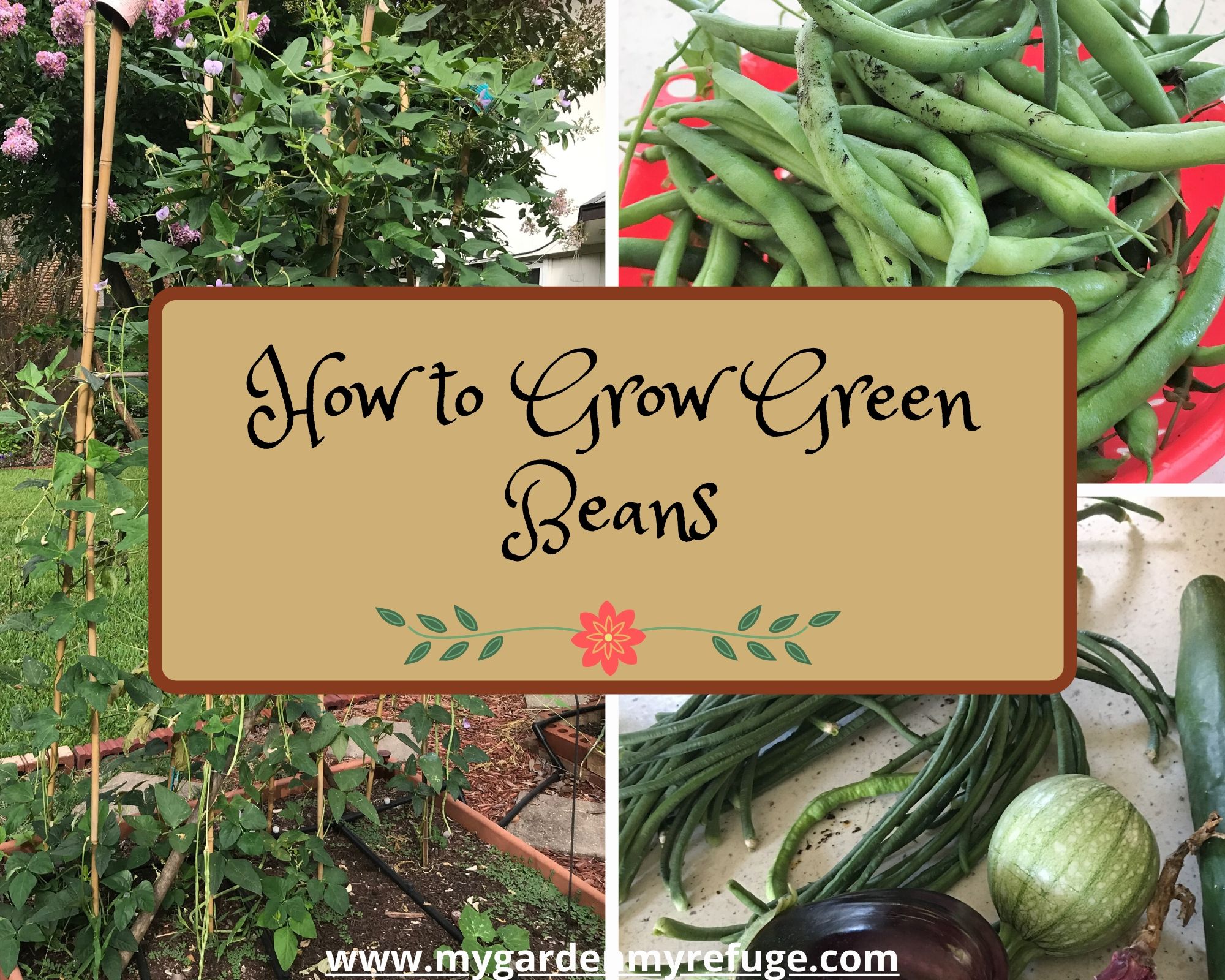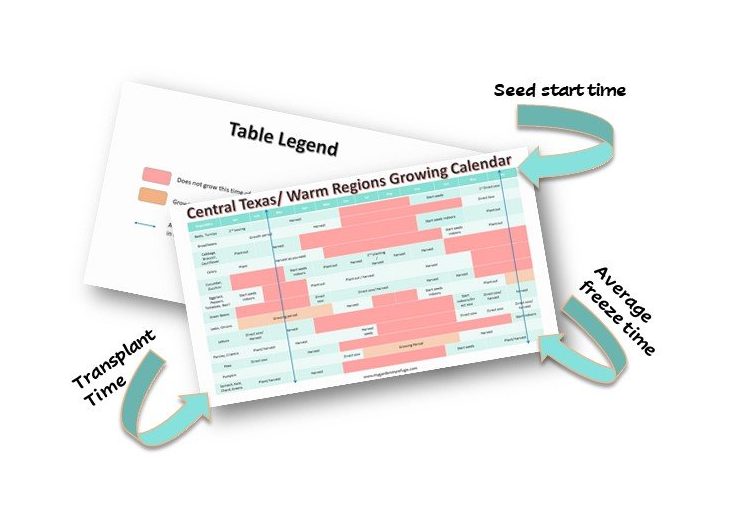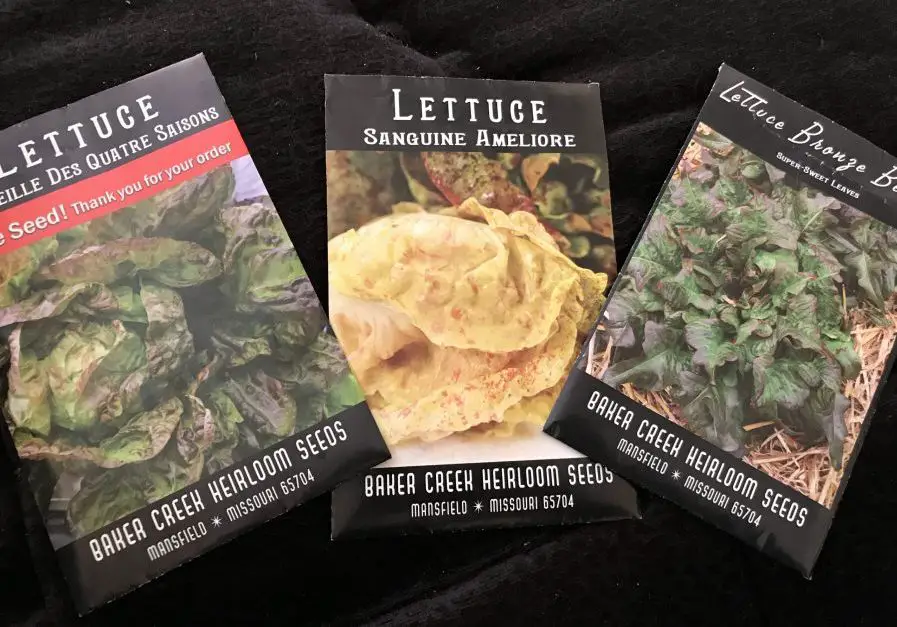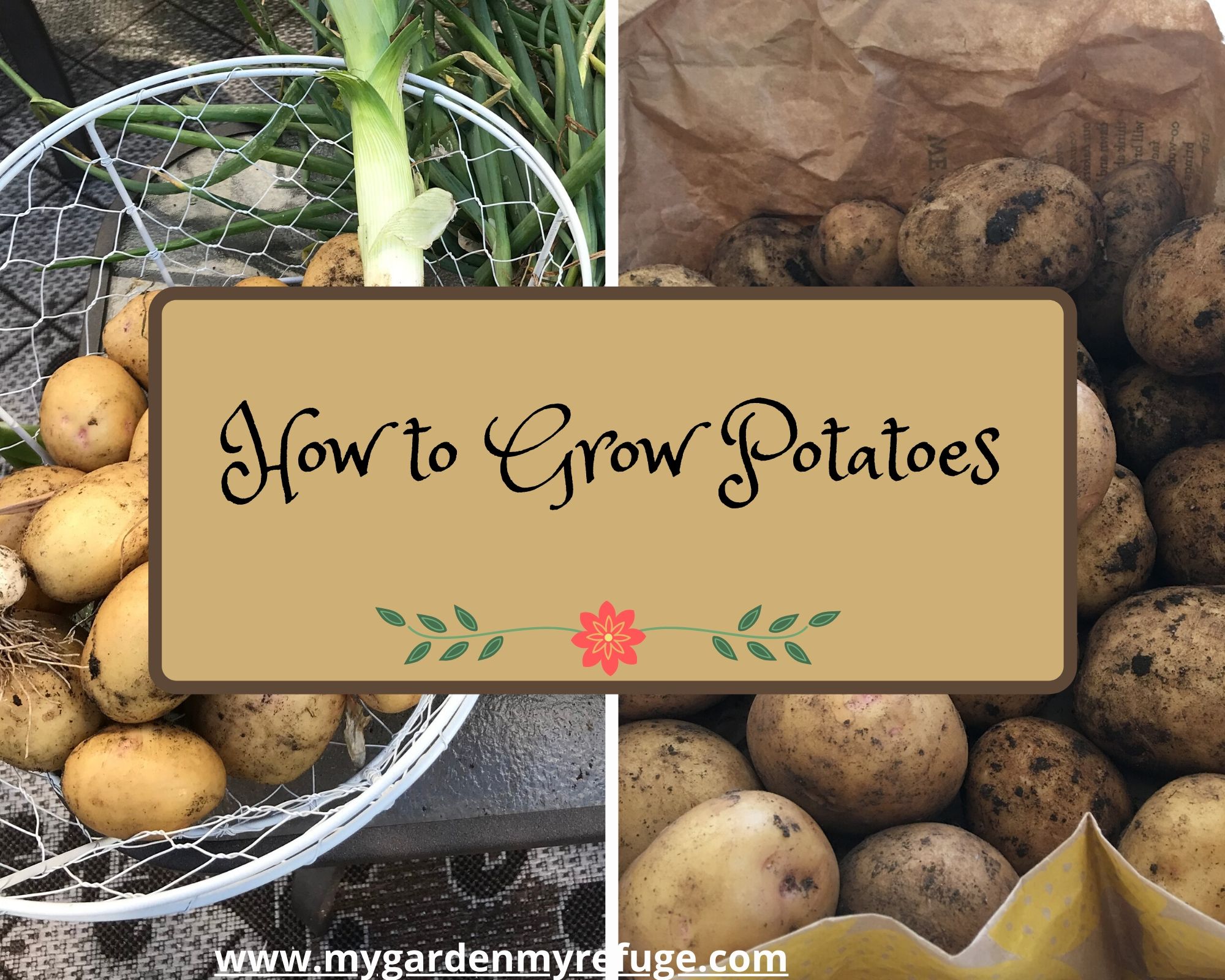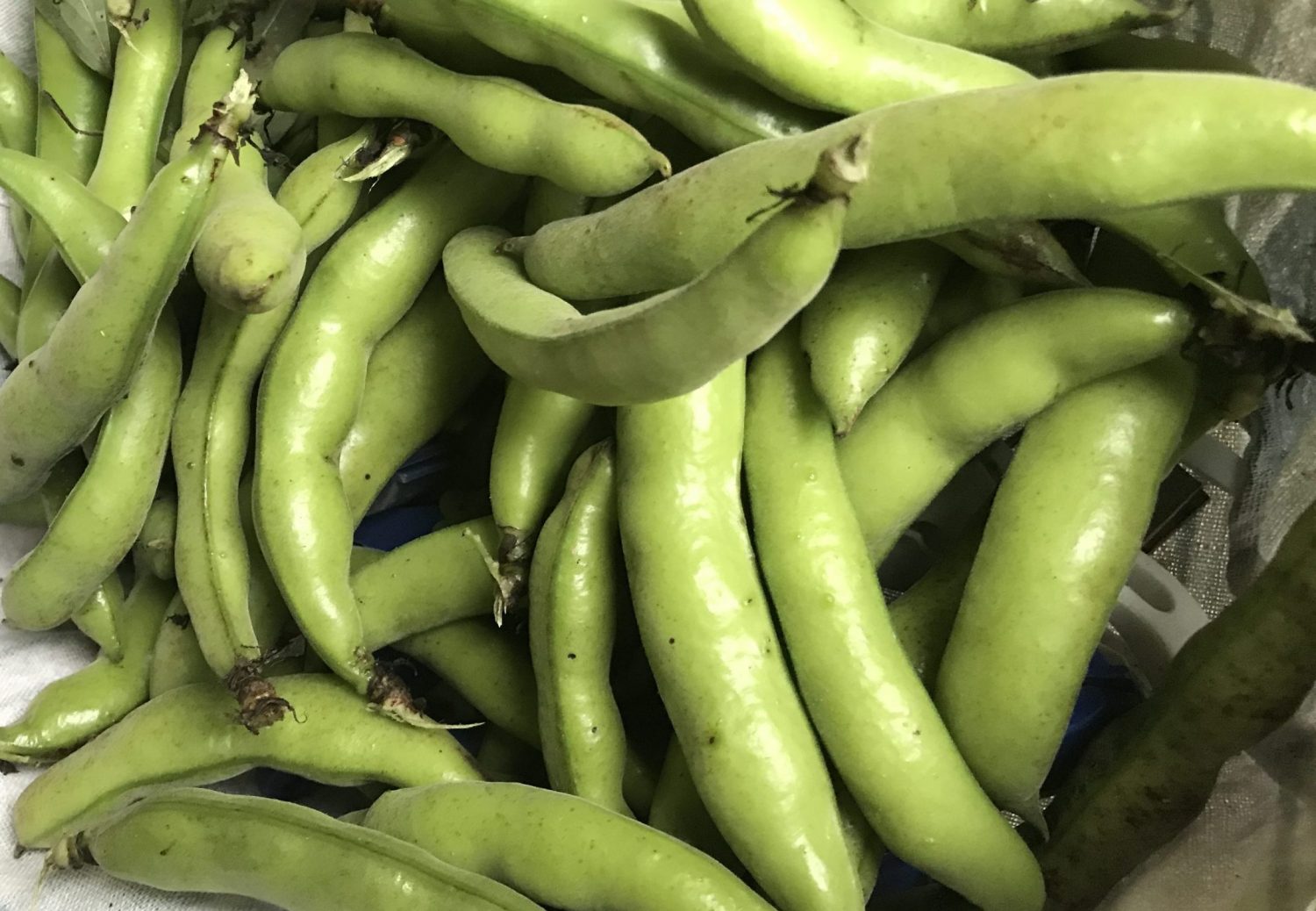When I decided to grow green beans in my Central Texas garden, I thought it would be a smooth and fun experience. Little did I know, growing green beans did come with a few challenges.
In this article, I will be sharing valuable information gained from personal experience. Also, I will show you the organic approaches I took as solutions to solve the problems I faced.
When to plant green beans?
Green beans are warm-season crops, meaning they grow in the summertime till frost. They are very delicate and do not tolerate low temperatures in the slightest. For this reason, there is no need to plant out early.
Green beans prefer mild temperatures, where nights are above 55F (12C) and 70F (21C) during the day.
The following is a timetable for growing green beans in Central Texas.
| Mar | Apr | May | Jun | Jul | Aug | Sep | Oct | |
| Green Beans | Start Seeds Indoors | Transplant/ Direct sow | Direct Sow/ Harvest | Direct sow/ Harvest | Direct sow/ Harvest | Direct sow/ Harvest | Direct sow/ Harvest | harvest |
To get ahead start on the seasoning, March is the time to start your seeds indoors if you want. Outside planting usually begins in April with extra caution. Sometimes, we get a sudden cold front or a freeze, which requires us to protect the plants.
May through September is the window for direct sowing green beans. Many sowings with time intervals allow continuous and steady harvest.
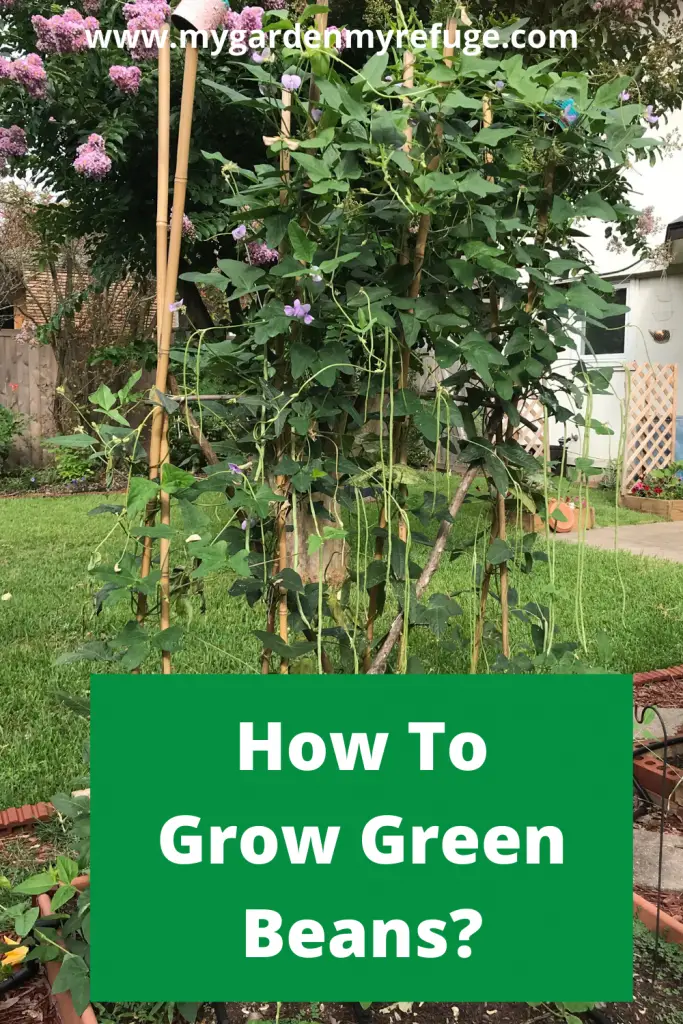
Types of green beans
There are two types of green beans: pole and bush beans. Check out the table below for a brief comparison between the two to help you make the right choice for your garden.
| Pole Beans | Bush Beans |
| Climbers | Small bush |
| Need a support system | Need ground space |
| Steady production | Produces in one flash |
| Fewer bug issues | Several bug issues |
| Very space-efficient | Not very space-efficient |
| Moderate growth speed | Fast growth speed |
Pole beans grow on trellises, which makes them good space savers. Planting two 8 feet rows, one foot apart, provides plenty for us through the summer. While the same ground area planted with bush beans does not. Also, pole beans have a steady production throughout the season.
I want to clarify that I do not intend to grow bushels of green beans for long-term storage. At this point, the small garden provides us with enough food for the given season with a little extra to store.
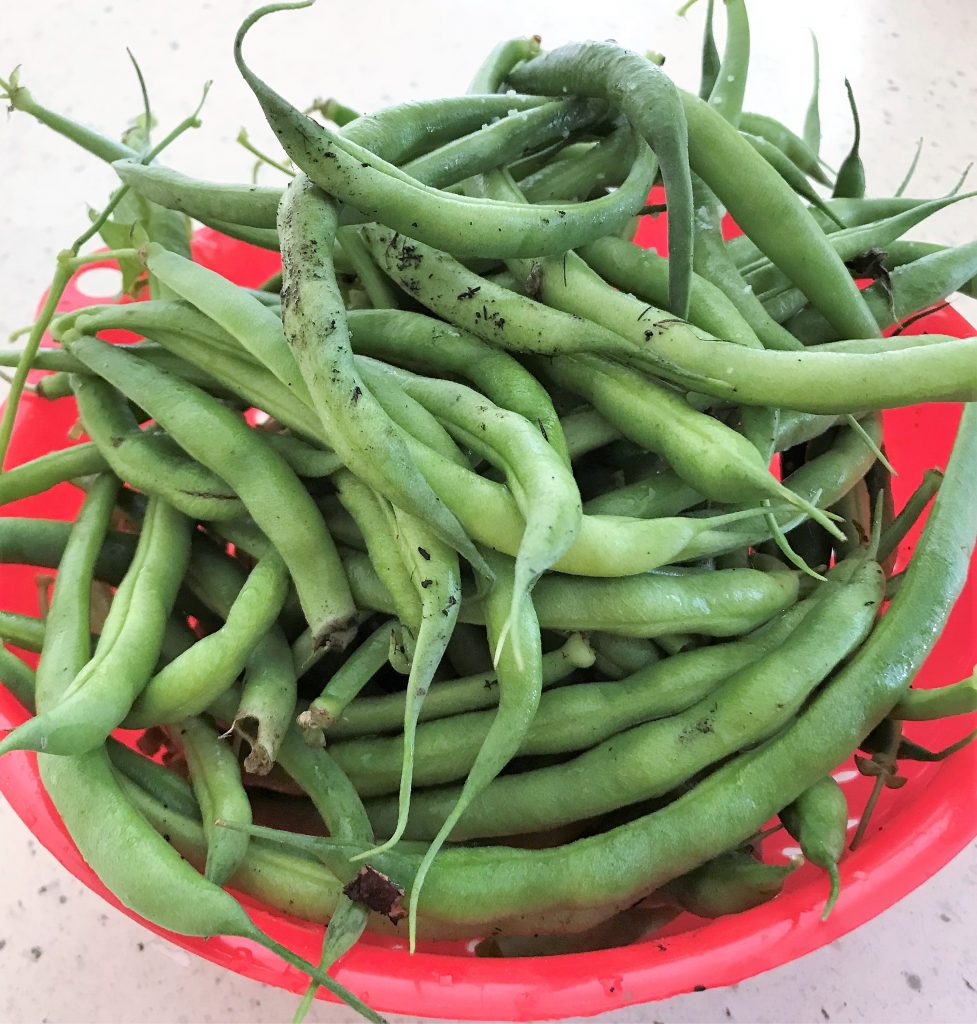
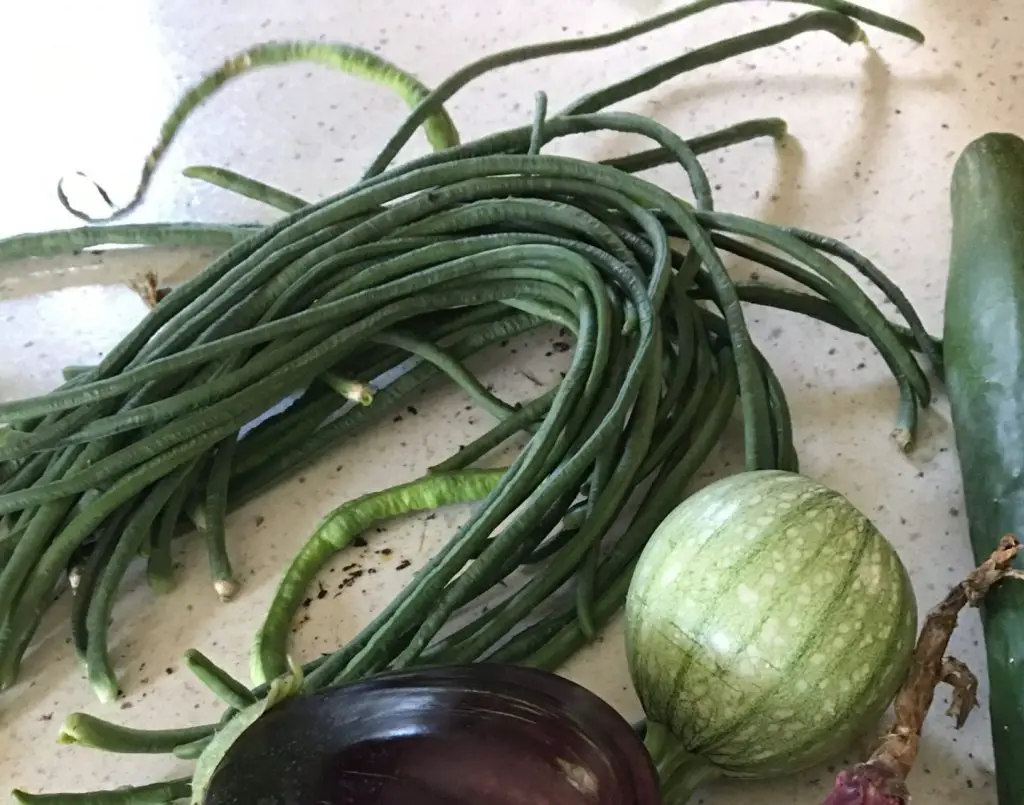
Varieties of Green Beans
There are many varieties of green beans other than the common ones. Some are skinny and long, while others are flat. Some are pale green, purple, brown, or bicolor.
My favorite Pole bean that I grow year after year is Yard Beans, also known as Chinese green beans. I grow Calima green bean too for bush type.
Direct sow or start seeds indoors?
Green beans germinate fast, so direct sowing is more common amongst gardeners. But, it is possible to start them indoors, two or three weeks before the start of the season. Yet, it is important to make sure the seedlings do not get root-bound.
How I “Plant Plan” my green beans?
Mid-March: I start 1st batch of pole beans indoors, to get a head start.
April: Plant them out after all threat of frost is gone.
May: I direct sow my second batch of pole beans.
June-July: I maintain the plants and harvest.
September: I plant my bush beans for the fall harvest.
Being root-bound is when the root system grows too much and becomes tight in the pot. It stresses the plant and can hinder its growth, which may affect production.
There are two reasons why you may choose to start seeds early.
- Lingering frost threat.
- The growing space is still occupied by the previous season crops.
How long does it take for green beans to germinate?
Before sowing green beans, it is best to soak them overnight to speed up germination. Fresh green beans seeds take four to five days to germinate.
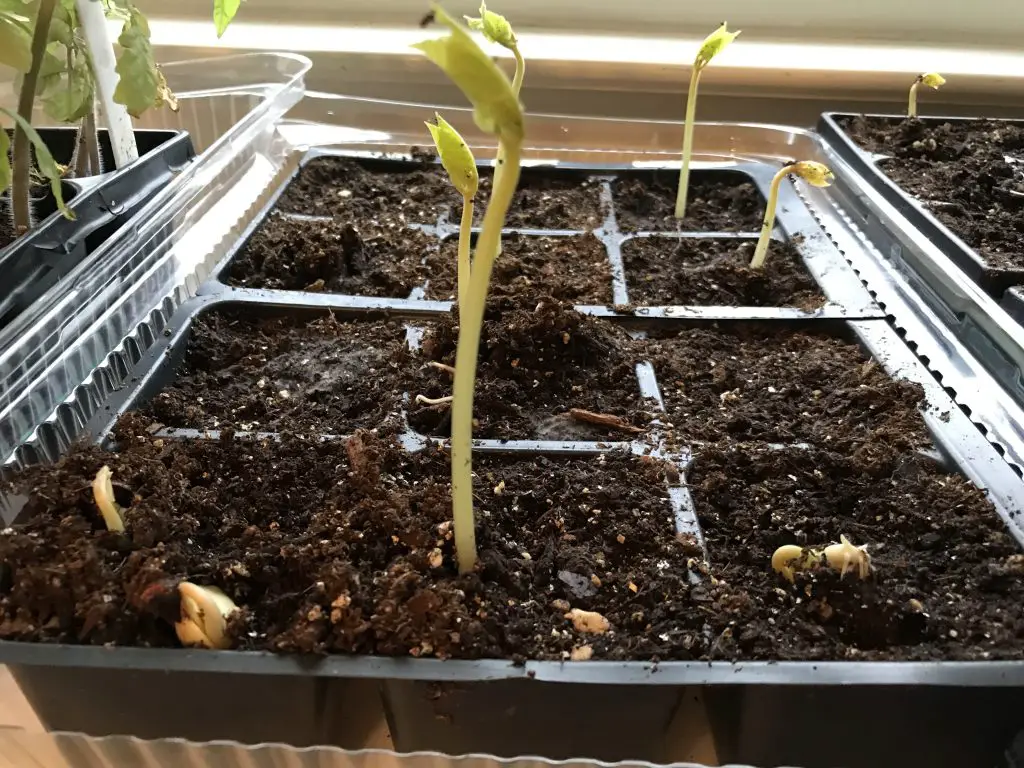
What is the best soil to grow green beans?
Green beans are not very demanding when it comes to soil conditions. Amending heavy clay soil with compost improves drainage, preventing the seed from rotting.
How much sunlight to grow green beans?
Beans are flowering plants; thus, they need full sun for the best production. They can take some shade but not too much. More than six hours of direct sunlight is ideal, and a few hours of afternoon shade is not bad.
How to space green bean plants?
Green beans are space savers. Following the Square foot garden method, it is possible to plant nine plants per square foot. Yet, I find it too close and does not help with pest control. I prefer to put four plants in one square foot.
For pole beans, I put one bamboo cane in the middle of one square foot area then I surround it with three plants. Once the plants start growing, they hang on to the pole and climb it up. The space between the posts/canes is one foot in all directions.
Watering green beans
It is important to water green bean plants regularly, allowing some dry time between each watering. But do not let them stay dry for more than four days. It may cause them to stop producing and make them more susceptible to pests.
Should I fertilize my green bean plants?
The short answer is no.
The long answer is that green beans are nitrogen fixers. They have a symbiotic relationship with a certain bacterium that lives in their roots. This bacterium processes the oxygen absorbed from the air and turns it into usable nitrogen for the plants. When the plants die, the leftover nitrogen remains in the soil, thus, improving its fertility for the next crop.

How long does it take from planting to harvest?
The flowering stage for green beans starts two to three weeks after the planting. Make sure to harvest regularly it will encourage the plant to produce more.
Supporting climbing green beans?
In the first years of growing greens, I used different support systems. At last, I settled on two designs. They are both Do-It-Yourself projects and easy to realize.
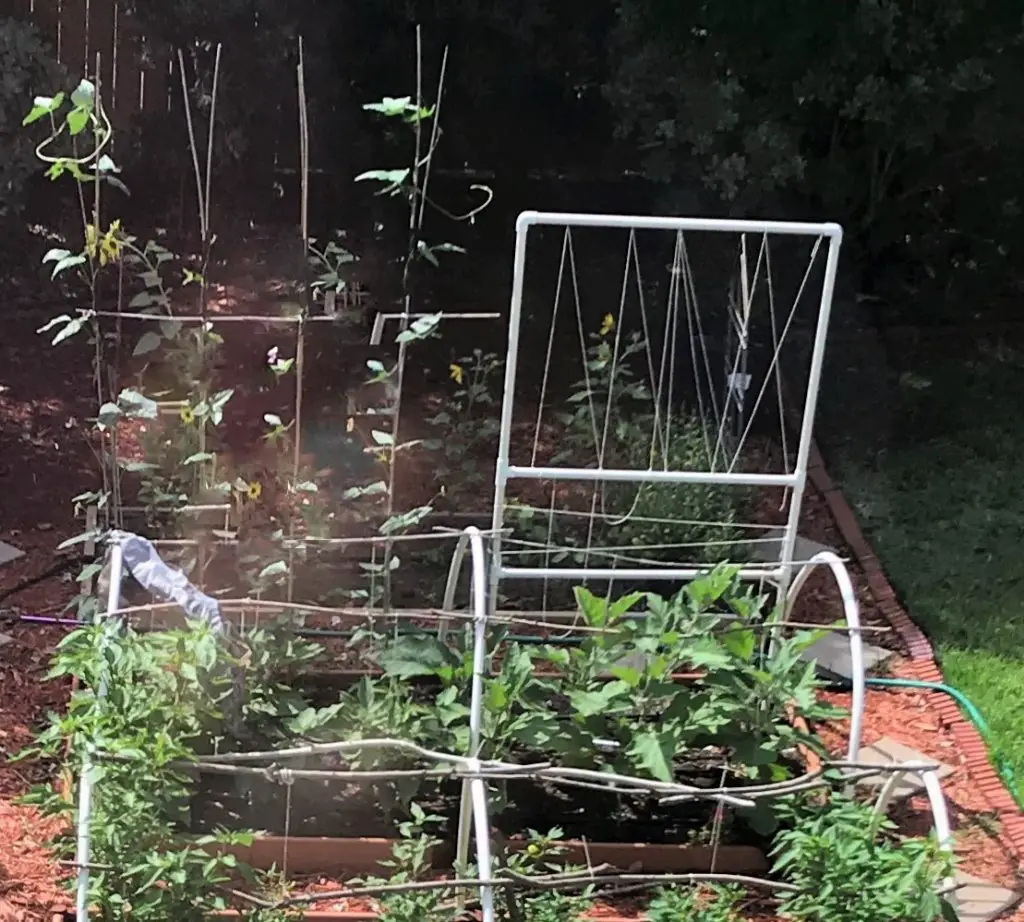
1- PVC pipes and netting structure: I make a 4 by 6 vertical frame to hold a garden netting and use R-bar to anchor it in the soil. This trellis tends to lean over when the plants are loaded with fruit. To reinforce it, I screw T-posts on each side. (shown on the right of the picture)
2- Tree branches or bamboo canes: This traditional support system is the most popular. It is easy to put together with free material unless you need to buy bamboo. (seen on the left)
Is the three-sisters’ method effective?
The three sisters’ method refers to planting zucchini, corn, and green beans together. The beans use the corn stalk as support, while zucchini occupies the ground and acts as mulch.
In central Texas, it is not easy to use the three-sisters method due to the squash vine borer. Our squash needs to be covered to protect it from the dreaded moth. The cover does not allow planting corn and beans within the same bed as squash.
What pests attack green bean plants?
Green beans are not problem-free plants. Pests and diseases can make growing them a challenge to some gardeners.
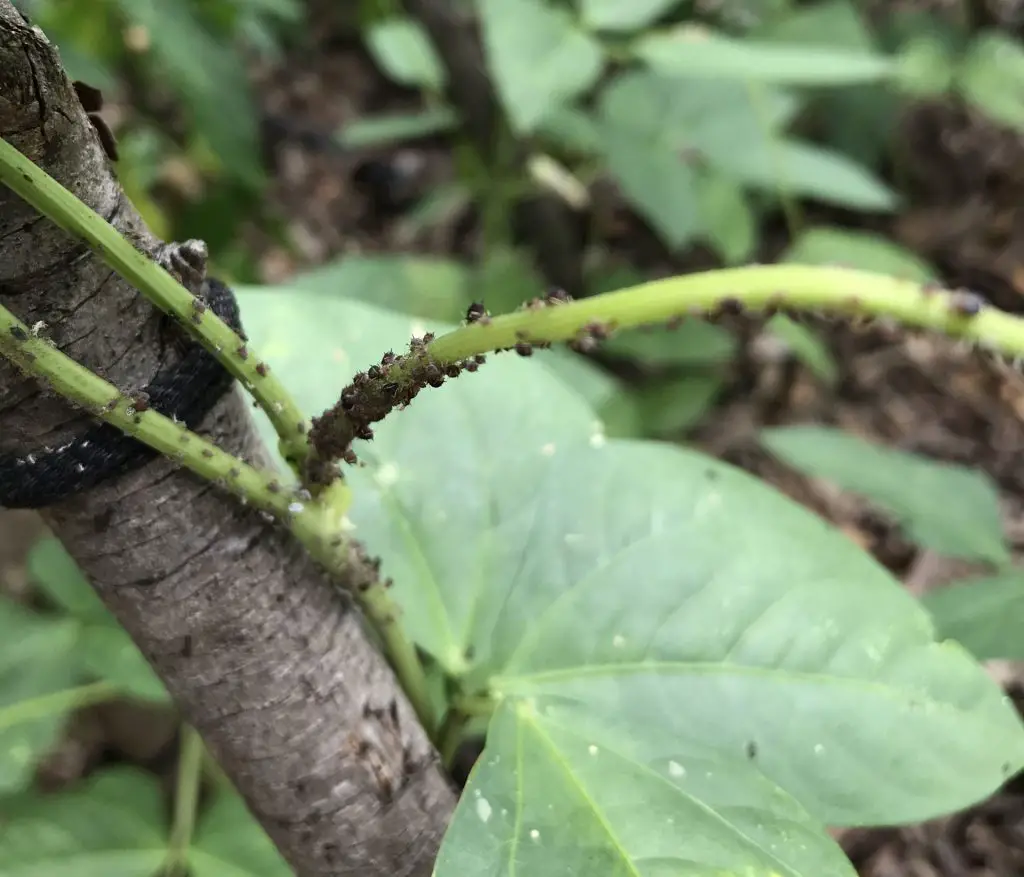
- Aphids are tiny green or black insects. They congregate on the new growth to feed on the leaf’s sap.
- Ants are attracted by the sticky substance secreted by the aphids.
- Spider mites are very small insects. To find them inspect the underside of the leaf. You can also shake the leaf over a white piece of paper. They, too, suck on the leaves until they turn yellow and then die.
- Stink bugs are armor-like shaped bugs. They come in different colors, but mostly grey or red with dark speckles. At their juvenile stage, they look like red spiders and gather on the tips of the plant. Controlling them as soon as possible is the best way to save the plant. Knock them down into a jar filled with soapy water.
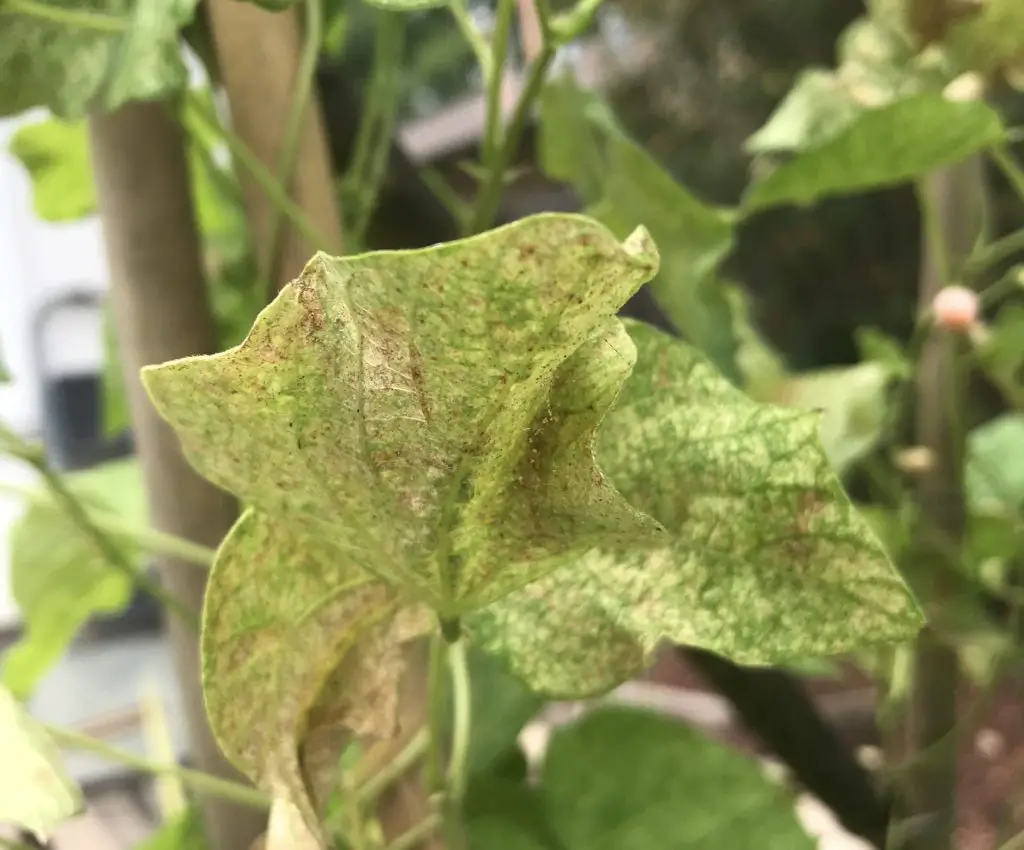
How to get rid of Aphids and spider mites on green beans, organically?
The organic way to control aphids and spider mites is by washing the plants by applying a strong jet of water. The water dislodges the insects and disturbs their reproduction cycle. Two to three applications a week should help. For this method to be effective, you must apply it several times a week.
When the infestation is too bad, and the water jet does not seem to be enough, an organic pesticide could help. Neem or Orange oil mixed with water and a drop of soap is pretty good at dealing with insects.
The oil sticks to the insect’s body and dries them out to death. It is best to apply the solution late in the evening to prevent sun exposure from burning the leaves and killing the plant.
It is necessary to attract beneficial insects to your garden?
Ladybugs and their pupae are the main aphid predators. You may buy them from a local nursery if they don’t come around your garden naturally.
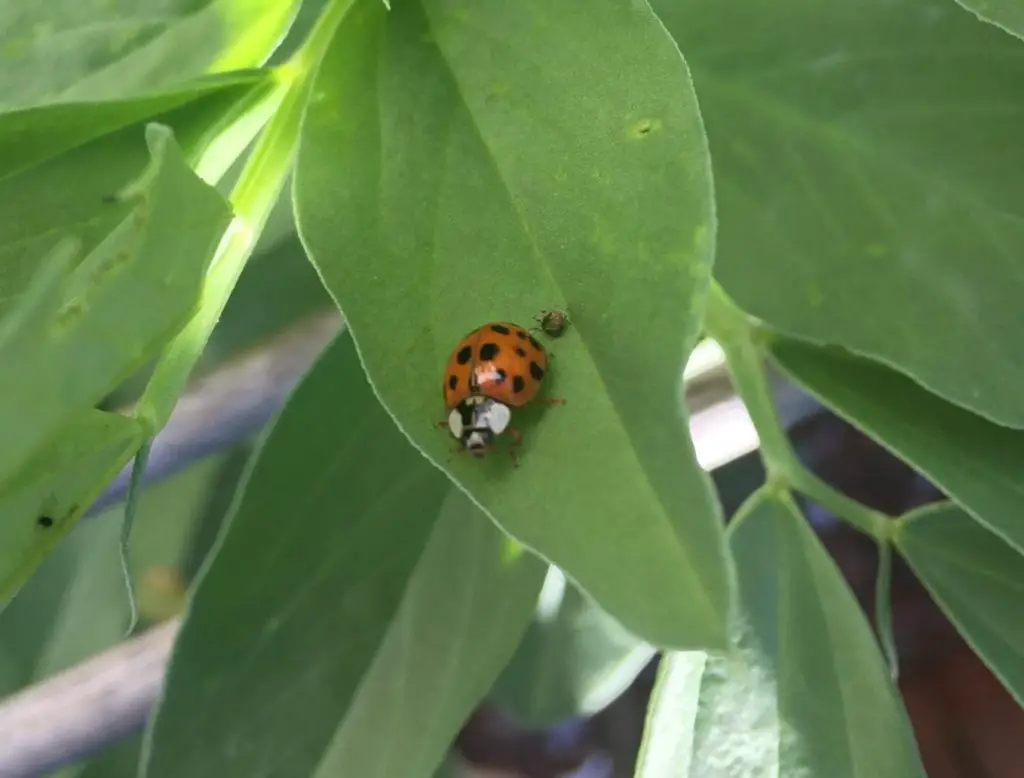
What is the redish color on the green bean plants?
The reddish or orangish color on the bean leaves is rust. It is a fungal disease that appears as rust-colored patches or dots on the leaves, stems, and pods. It thrives in humid and warm climates.
Prevent rust by planting rust-resistant varieties and avoiding crowded planting. Otherwise, you may use organic copper or Sulphur treatment on the leaves. Check with your extension agency for proper guidelines before applying such treatment.
Yellowing of green bean leaves
There are a few reasons why the leaves turn yellow.
- Too much water: Too much rain or overwatering may deprive the plants of the nutrients found in the soil by diluting them or washing them away.
- Too little water: Scarce watering, also, turns plants yellow. Water is an essential element in the plants’ natural processes. If they don’t get the right amount of water, they fail to produce the necessary energy to ensure healthy growth.
- Insects: Spider mites survive by sucking on the leaves’ sap. Eventually, yellow patches begin showing on the leaves until they dry out and die.
The solutions
- Regular watering ensures healthy plant growth. If excessive rainfall is the issue, the plant should recuperate once the weather settles.
- Establish a good pest control routine to lessen insect damage.
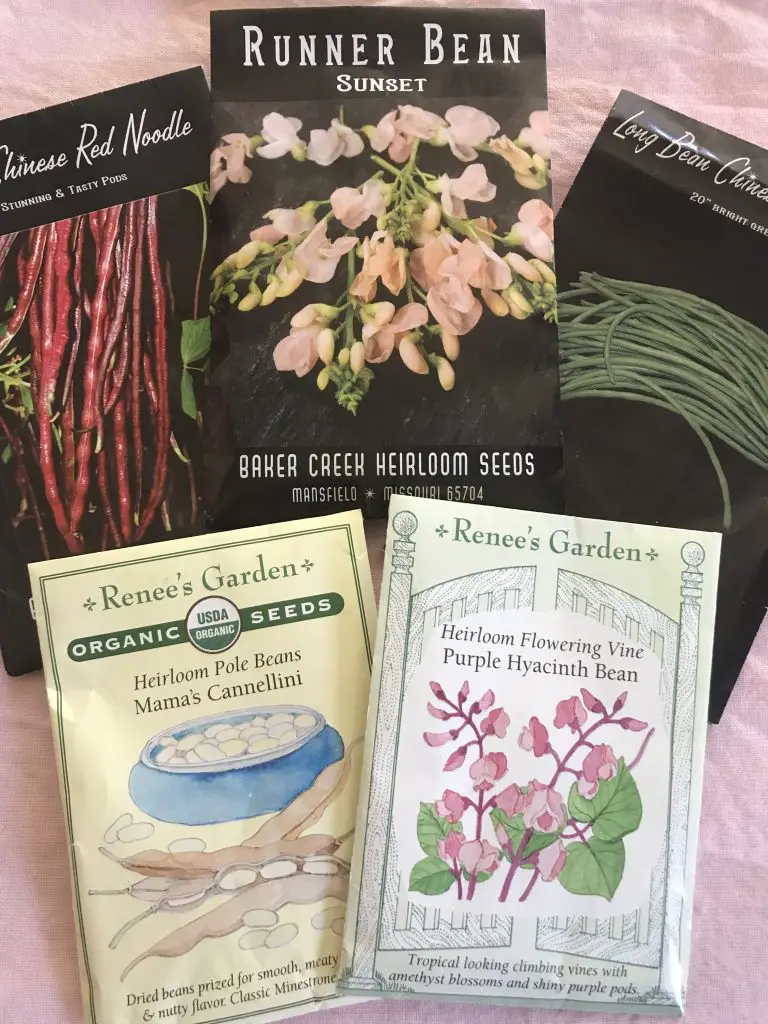
Green bean plants are beautiful and add a lot of interest to the vegetable garden. The different growth patterns, flower color variation, and hanging beans it is just fascinating to look at it.
In the kitchen
Green beans are present in every cuisine around the world. In my house, they are a nice crunchy snack for my kids. We also enjoy them in many recipes.
- Steamed green beans with couscous.
- Green beans Shakshouka.
- Oven-baked green bean stew
- Crockpot Honey Chicken & Green Beans
- Zucchini & Green Beans Stir Fry
